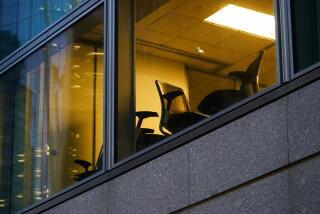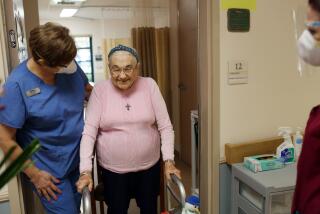1 in 5 who had jobs in February lost them the next month, study finds
- Share via
WASHINGTON — As 3 million more Americans sought jobless insurance benefits in the last week, the numbers reflected a well-established fact: When the economy stumbles, the pain falls first and hardest on those least able to bear it.
A study released Thursday by the Federal Reserve suggested that 1 in 5 adults with jobs in February were hit with layoffs by early April and that those at the lower end of the income curve were at least twice as likely to be thrown out of work.
“It’s like we have the same storm, but we have very different shelters,” said Mary Daly, president of the Federal Reserve Bank of San Francisco. “Some of us are well-sheltered. We can tele-work. We [have] college degrees. The work we do is more resilient to the shelter-in-place and the coronavirus.”
Others are “almost completely unsheltered,” she said in an interview. “When we shut down the economy, they have to go home. ... And they’re in industries that may be the slowest to recover.”
Those industries include leisure and hospitality, such as restaurants and hotels, as well as certain types of gig work. In California, around 400,000 to 500,000 people per month are generating some income as app-based rideshare and food delivery drivers, according to a soon-to-be published study by the Berkeley Research Group. The vast majority are using the driving jobs to supplement their incomes — around 80% of all drivers work less than 20 hours per week.
“It follows that as main parts of the on-demand labor platforms have seen demand dry up in the past two months, the impacts have been greatest on lower income workers,” said Michael Bernick, an employment lawyer at Duane Morris in San Francisco.
But if the immediate impact is uneven, more fortunate workers who tend to be better educated and higher-skilled will likely share that pain before the present crisis ends.
In today’s highly interconnected economy, what happens to one part of the work force sends ripples through the system, eventually inflicting damage on all but the wealthiest.
“It’s just not possible that the economy is going to kick into full gear without their participation,” Mark Zandi, chief economist at Moody’s Analytics, said of the more vulnerable workers.
The Fed’s study, coupled with the new numbers on jobless insurance claims, suggested that the nation’s real unemployment rate last month was closer to 20% than the 14.7% reported on Friday by the government.
Goldman Sachs, an investment banking firm, is now projecting a jobless rate of 25% in the second quarter, on par with the peak unemployment level during the Great Depression in the 1930s.
The Fed report on the pandemic’s impact was added to its 2019 survey of the economic well-being of Americans, which found that financial conditions for most people were generally positive at the end of last year.
But the economic ground underneath many families shifted dramatically in March as the coronavirus outbreak forced lockdowns and businesses began closing.
In addition to about 20% of working adults who were hit with layoffs in March, another 6% of adults had their hours cut or took unpaid leave.
It was much worse for those with the least financial means: Nearly 40% of adults in households with incomes under $40,000 — roughly a third of all households — reported a job loss in March.
In one encouraging sign, the Fed survey found that 8% of those who experienced a job loss took on side work to supplement their income. And overall, 9 in 10 people who lost a job said their employer indicated that they would be recalled at some point.
Even so, in 77% of the cases, employers did not give workers a specific return date. And many economists worry that a significant share of furloughs will turn into permanent separation from employers, lengthening periods of unemployment for many people and costing employers as they eventually need to spend to recruit and train new workers.
“My own view is that the recovery is going to be gradual, that it will not be V-shaped,” Daly said, referring to a pattern of sharp decline followed by a rapid upswing — something that President Trump and a minority of economists are predicting.
“When I project out, what I see is a recovery that has stages,” Daly said. “It has to be gradual because we’re trying to figure out how much we can come back to work and how much to reengage in our economic life without flaring the virus… If you’re going to come in gradually with a phased approach, you’re naturally going to have a flatter trajectory of the recovery.”
In the final years of record-long economic growth after the Great Recession of 2008-09, lower-income and middle-income workers and families made some meaningful income gains.
But many still live paycheck to paycheck, and the Fed study conducted last October found that about 40% of adults overall would have trouble meeting a $400 unexpected expense, such as a medical bill.
For now, the federal government’s nearly $3-trillion in pandemic relief aid to individuals, businesses and states has filled some of the gap in lost incomes, enabling households to make rent, mortgage and other payments, or in some cases getting forbearance from landlords and lenders.
But as the economic downturn and unemployment are prolonged, the deepening financial stresses to tens of millions of lower-income households threaten to do long-term, even permanent, damage to workers’ earnings and drag down the overall economy.
“It’s the difference between a flourishing economy and one that’s middling along,” Zandi said. While lower-income households represent a smaller part of the economic pie, he said, their spending is vital to the economy.
Moreover, the struggles of lower-income workers will put greater pressure on already-strapped state and local government finances as more aid will be needed to help lift workers and households from ruin, for healthcare, unemployment and income support.
“We are all in this together,” Zandi said. “It’s hard to imagine that the economy can flourish with half the population struggling just to make financial ends meet.”
Last Friday’s jobs report for April revealed some of the large gaps in the economic and employment landscape. Even with the data underestimating unemployment rates, the jobless figure for African Americans last month stood at 16.7%, and it was 18.9% for Latinos, compared with 14.2% for whites and 14.5% for Asians.
The gap was much bigger by education: Unemployment for workers with less than a high school education was 21.2% last month, and it was 17.3% for high school graduates — more than double the jobless rate for people with college degrees.
“If you think of the coronavirus as putting a giant magnifying glass on these inequities in education, you can see the impact they have on people’s lives and our economy,” Daly said. “We have too large of a fraction of our workforce that’s idle, and getting them back [will require] a doubling down on ensuring that people have the education they need to take the jobs being produced and are more resilient to these types of shocks.”
Thursday’s jobless claims report from the Labor Department showed that 2.98 million people applied for unemployment benefits in the week ending May 9. That’s the fifth straight week of declining applications, but it remains at an astronomically high level and brought the total number of new jobless claims filings since mid-March to 36.5 million.
Many workers have been waiting weeks, even months, for benefit checks. As of April 25, the latest available, 21.7 million people were on the rolls for unemployment claims, according to seasonally unadjusted data.
In addition, the Labor Department said that 3.4 million people had claims for unemployment benefits under a special pandemic program for independent contractors, gig workers and others who are not traditional wage earners. Another 2.6 million people in this category of work have filed initial claims since mid-April.
More to Read
Get the L.A. Times Politics newsletter
Deeply reported insights into legislation, politics and policy from Sacramento, Washington and beyond. In your inbox twice per week.
You may occasionally receive promotional content from the Los Angeles Times.











